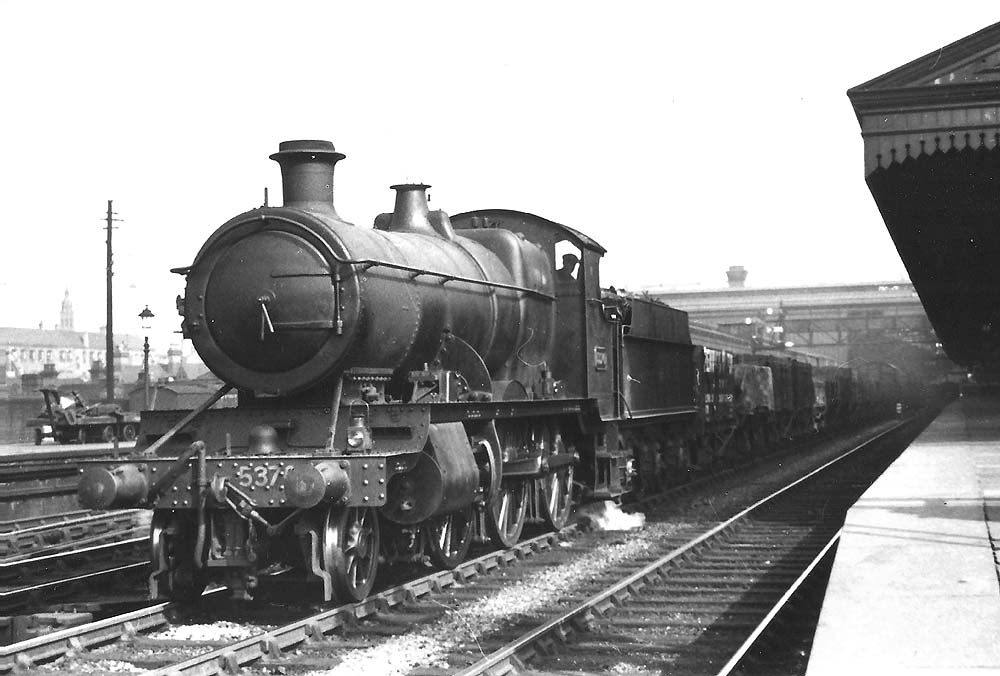 |
|
GWR Route: Banbury to Wolverhampton
GWR Route: North Warwickshire Line
Birmingham Snow Hill - British Railways Period Locomotives:
gwrbsh2489
 |
Great Western Railway 2-6-0 43xx class No 5370 with a down
freight passes through the centre of Snow Hill Station on the main road on
Saturday 5th June 1937. The single red lamp on the left of the buffer beam
indicates that this is a class K train. This class of trains might require
intermediate stops within a section. Locomotive No 5370 was completed on 10th
June 1919 at Swindon Works as part of lot 208 with the average cost of the
locomotives in this lot recorded as £4,582. These were part of a very
successful class of mixed traffic locomotives designed by Chief Mechanical
Engineer George Churchward and introduced in 1911. Unsurprisingly the 43xx
class had all the typical Great Western Railway features of the period; tapered
domeless boiler, belpaire firebox, drumhead smokebox, superheating, topfeed
combined with safety valve bonnet and graceful curved drop ends. No 5370 was
turned out in unlined green with brass features painted over in deference to
the period of austerity brought about by the world war. The war also increased
the demand for freight engines, both at home and abroad, with eleven 43xx class
locomotives supplied to the Railway Operating Division and shipped to France in
1917 for use on the Western Front. These were returned by the end of 1919, at
which point the class contained 180 locomotives. With the usefulness proven,
construction continued apace and by 1932 the class contained a total of 342
locomotives.
The 43xx class locomotives were fitted with standard No 4
boilers operating at a pressure of 200 lb, which produced a tractive effort, at
85% of 25,670 lbs, classifying the locomotive in power group D. The maximum
axle weight was originally 18 tons, 4 cwt, but in 1917 this was reduced to 17
tons, 13 cwt by moving forward the pony truck fulcrum. Those locomotives
modified were marked with a red ‘K’ on the cab side until all the
class had been completed. The axle weight limited the locomotives to main lines
and some branch lines – route colour Blue. Over time minor modifications
changed the locomotive's appearance; after 1926, shorter safety valve bonnets
were gradually introduced and after 1928, when new cylinders were required on
older locomotives, a new pattern with outside steam pipes were fitted. These
assisted maintenance by improving access to the boiler tubes. By April 1932 all
the 43xx class had received Automatic Train Control (ATC) and in the photograph
the detector can be seen on No 5370 between the front pony truck wheels. It is
not known when the shorter safety valve bonnet was fitted to No 5370, but this
locomotive received new cylinders with outside steam pipes in March 1945.
No 5370 was initially allocated to Chester shed (CHR) and was
also known to have been allocated there in January 1921. At the Grouping in May
1922, No 5370 was recorded at Banbury shed (BAN) and in January 1934 was known
to have been allocated to Oxley shed (OXY) outside Wolverhampton. In January
1938, No 5370 was known to have been allocated to Tyseley shed (TYS), was there
in December 1947 just prior to nationalisation and was also known to have been
allocated there in both August 1950 and March 1959. No 5370 was withdrawn from
Llanelly shed (87F) in week ending 16th September 1960 having completed
1,213,420 miles. The locomotive was recorded as being cut up at Swindon on 29th
October 1960.
The 43xx class locomotives were normally paired with standard
Churchward tenders of 3,500 gallon water capacity and which could hold 7 tons
of coal. They were fitted with a water scoop arrangement for replenishing the
tank from water troughs like those at Rowington. In 1934 No 5370 was known to
be paired with tender No 1821. This was a 3,500 gallon standard Churchward
tender built in December 1911 under lot A82.
Robert Ferris
 back back

|
